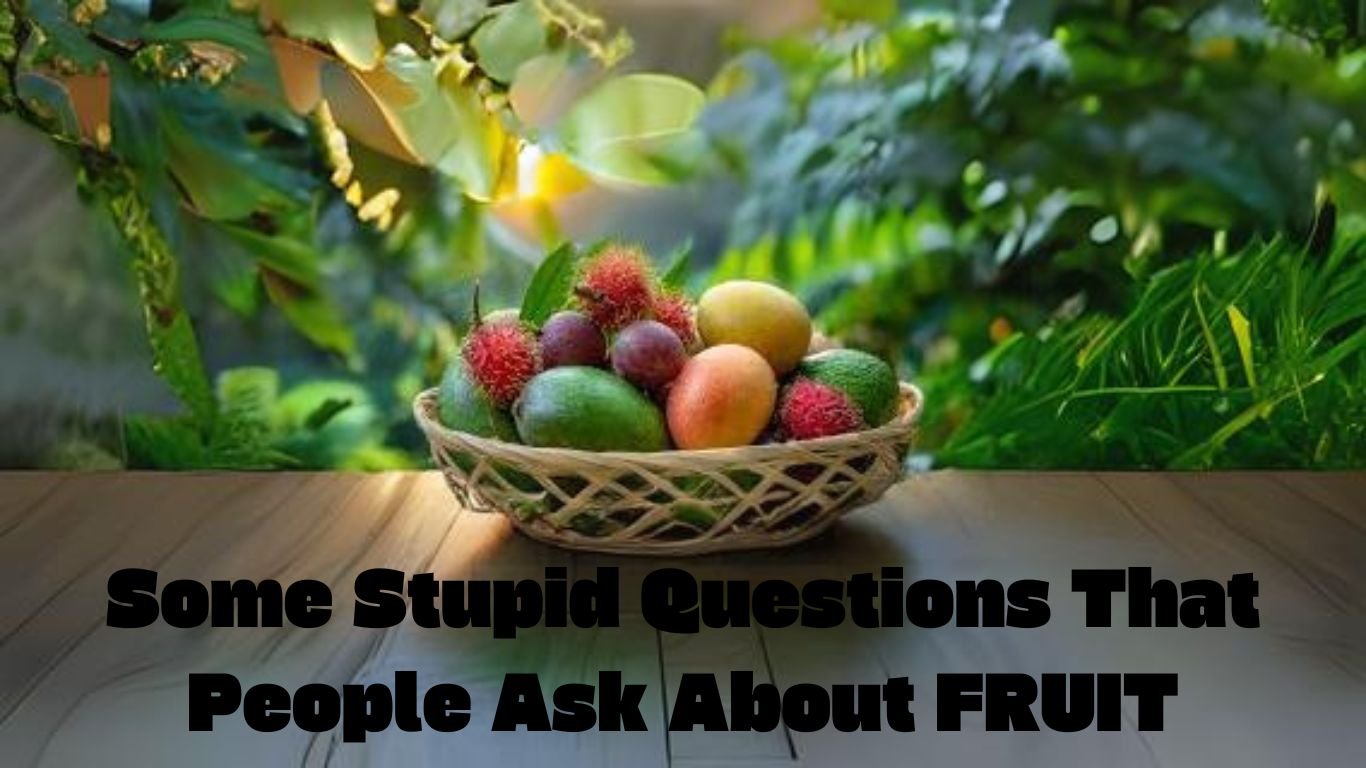Some Stupid Questions That People Ask About FRUIT

Here is the first question that people ask about fruit:
1. Can Hens Eat Kiwi Fruit?
Yes, hens can eat kiwi fruit, which can be a healthy treat. Many people wonder, “can hens eat kiwi fruit?” The answer is yes! Kiwi is safe for hens and is packed with vitamins, especially vitamin C, which is essential for their health and can help boost their immune system.
However, it’s best to give kiwi in small amounts. Too much fruit can upset a hen’s stomach because it contains a lot of sugar. So, when you ask, “can hens eat kiwi fruit?” remember to serve it in moderation. When you feed kiwi to your hens, always make sure it is fresh and clean to avoid any dirt or pesticides. Removing seeds is also good, as they could pose a choking hazard. Providing a variety of foods, including fruits like kiwi, can keep your hens happy and healthy, but remember to balance it with their regular feed.
I hope you find the answer to “Can Hens Eat Kiwi Fruit”
2. Does Monk Fruit Have Lutein?
When people ask, “does monk fruit have lutein,” they are curious about the nutritional benefits of this popular sweetener. Monk fruit, or luo han guo, is a small green fruit from Southeast Asia. It is mainly used as a natural sweetener because it is low in calories and contains no sugar. However, if you’re wondering, “does monk fruit have lutein?” the answer is no. Monk fruit does not contain lutein, a type of carotenoid found in many green leafy vegetables. Lutein is essential for eye health and can help protect against age-related vision problems.
So, when you think about the question, “does monk fruit have lutein?” it’s essential to know that while monk fruit is a great sugar alternative, it doesn’t provide this valuable nutrient. Instead, lutein is mainly found in foods like spinach, kale, and other colorful fruits and vegetables. These foods are rich in lutein and offer many health benefits. If you want to increase your lutein intake, focusing on leafy greens and other carotenoid-rich foods is the way to go.
In summary, if you’re wondering, “does monk fruit have lutein?” the answer is no. Monk fruit is healthy and can be a great addition to your diet for sweetness without calories, but it doesn’t provide lutein. For eye health, include a variety of vegetables and fruits rich in lutein in your meals.
I hope you will find the answer to “does monk fruit have lutein?”.
3. Can The Fruit Behind The Female Cucumber Flower be Harvested?
Yes, can the fruit behind the female cucumber flower be harvested? The answer is yes! When you see a female cucumber flower, it usually has a small cucumber forming right behind it. This small cucumber is the early stage of the fruit. Can the fruit behind the female cucumber flower be harvested if the flower is pollinated? Absolutely! As the cucumber grows, it becomes ripe and ready for picking.
It’s essential to wait until the cucumber is fully developed before harvesting. A common question is, can the fruit behind the female cucumber flower be harvested too early? While it’s possible to pick it early, the best flavor comes from allowing it to grow a bit larger. It would help if you aimed to harvest cucumbers when they are firm, green, and not too big. If you leave them on the vine for too long, can the fruit behind the female cucumber flower be harvested after it overgrows? Unfortunately, overripe cucumbers can lose their crispness and flavor.
To check if it’s the right time to harvest, gently squeeze the cucumber. If it feels firm, it’s ready! Using a sharp knife or garden shears, you can cut the cucumber from the vine, taking care not to damage the plant. In conclusion, can the fruit behind the female cucumber flower be harvested? Yes, but ensure it’s the right size and firmness for the best taste. Enjoy your fresh cucumbers in salads or as tasty snacks! If you have more questions about cucumbers or gardening, ask!
4. What Was The Largest Population Of Red-Moustached Fruit-Dove At Once?
The question “What was the largest population of red-moustached fruit-dove at once?” is not easy to answer because no exact historical record is available. However, before the introduction of predators and habitat destruction, these beautiful birds were once commonly found across their native Mariana Islands. Many researchers have tried to estimate the largest red-mustached fruit-dove population at once, but the exact numbers still need to be determined.
Over time, the species faced significant population declines, and conservationists continue to ask, what was the largest population of red-moustached fruit-dove at once before they became critically endangered? Today, their numbers are meager, and efforts are being made to protect and restore their population. The mystery of what the largest population of red-moustached fruit dove was at once remains, but safeguarding their future is the main priority now.
I hope you will find the answer to “What was the largest population of red-moustached fruit-dove at once four times?”.
5. What Dried Fruits Are in Tropical Trail Mix Papaya Allergy?
When individuals inquire, “What dried organic products are in tropical path blend? Papaya allergy? “It’s important to know that tropical trail mix often includes a variety of dried fruits. Some common ones are dried papaya, pineapple, banana chips, mango, and coconut flakes. However, if you have a papaya allergy, you should be cautious when consuming tropical trail mix.
The inquiry, “What dried fruits are in tropical trail mix papaya allergy?” highlights the need to check ingredients carefully. Since many trail mixes include dried papaya, asking, “What dried fruits are in tropical trail mix papaya allergy?” to avoid allergic reactions is essential. If you are allergic, look for trail mixes without papaya, or make your safe version home.
Tropical trail mix usually blends dried fruits and nuts, making it a tasty and healthy snack. The dried fruits often found in tropical trail mix include:
- Dried papaya – Sweet and colorful.
- Dried pineapple – A bit tangy and sweet.
- Dried banana chips – Crunchy and slightly sweet.
- Dried mango – Soft, chewy, and sweet.
- Coconut flakes – Add a tropical flavor.
Some mixes might include nuts like almonds, cashews, or seeds, which add protein and crunch.
Hope you find answer of “What Dried Fruits Are in Tropical Trail Mix Papaya Allergy”.
6. Where To Buy Lychee Fruit?
Several good options exist if you’re wondering where to buy lychee fruit. Many local grocery stores carry fresh lychee, especially during the summer when it’s in season. Another great place to look is Asian markets, as lychee is prevalent in many Asian countries. They often have fresh lychee fruit available, as well as canned versions.
If you prefer shopping online, you can find where to buy lychee fruit on websites like Amazon, which sells fresh and canned lychee. Additionally, visiting farmer’s markets can be a good idea during the lychee season, as some local growers might sell fresh lychee there. So, when you ask where to buy lychee fruit, you have various options to explore!
7. Are Olives a Fruit or a Veggie?
When we talk about olives, many people wonder, “Are olives a fruit or a veggie?” The answer is that olives are fruits! This might surprise some people because we often consider fruits sweet and juicy, like apples or strawberries. However, olives are different. Let’s explore why olives are considered fruits and what this means.
First, let’s look at the definition of a fruit. A fruit is the part of a plant that develops from its flowers. Fruits usually contain seeds. Olives fit this definition perfectly. They grow on olive trees and produce flowers. Each olive has a pit inside, which is the fruit’s seed. So, when you ask, “Is an olive a fruit or veggie?”It is, in fact, a fruit, which is the correct response.
You may think, “However olives don’t taste sweet!” That’s true! Most fruits are sweet, but not all of them. Some fruits, like lemons and limes, are sour, while olives are salty and savory. This is because olives are often cured or processed before we eat them. Fresh olives can be very bitter, so they are usually brined or soaked in water to make them taste better. So, even though olives are fruits, they have a unique taste that is different from what we usually think of as fruity.
Another interesting fact is that olives are a vital part of Mediterranean cuisine. They are used in salads, pizzas, and many other dishes. Olive oil, made from pressing olives, is also trendy.
At the point when you examine “Are olives a natural product or veggie?”, It is essential to acknowledge their role in healthy cooking. Olive oil is known for being good for the heart and can be a healthier fat choice than butter or other oils.
When we consider olives’ nutritional value, we can see why they are such a great food. Olives are rich in healthy fats, especially monounsaturated fats, suitable for your heart. They also contain vitamins and antioxidants, which can help protect our bodies from diseases. So, even though the question, “Are olives a fruit or veggie?” appears to be straightforward, it opens up a conversation about medical advantages and cooking
Many people might also ask, “Is an olive a fruit or veggie?” regarding how we use olives in our meals. While olives are technically fruits, they are often treated like vegetables in salads or as toppings. For example, in a Greek salad, olives are mixed with cucumbers, tomatoes, and feta cheese, showcasing how they can blend in with other foods.
In summary, “Are olives a fruit or veggie?” is an intriguing inquiry featuring the intricacy of food arrangement. Olives are fruits because they develop from flowers and contain seeds. However, their taste and culinary uses often make them seem more like vegetables. So, the next time someone asks, “Are olives a fruit or veggie?” you can confidently say that olives are fruits, even if they don’t taste like the sweet fruits we usually think of!
I hope you will find the answer to “Are olives a fruit or a veggie?”.
THANKS FOR READING.





